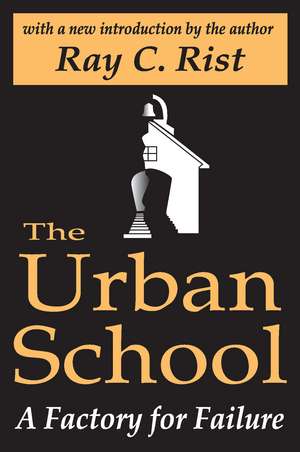The Urban School: A Factory for Failure
Editat de Christian Karneren Limba Engleză Paperback – 30 iun 2002
The Urban School: A Factory for Failure challenges these assumptions about American education. Indeed, a basic premise of the book is that the American school system is working quite well-doing exactly what is expected of it. To wit, that the schools in the United States affirm, reflect, and reinforce the social inequalities that exist in the social structures of the society. Stated differently, the schools are not great engines for equalizing the existing social inequalities. Rather, they work to reinforce the social class differences that we have had in the past and continue to have in more pronounced ways at present.
Rist uses both sociological and anthropological methods to examine life in one segregated African-American school in the mid-western United States. A classroom of some thirty children were followed from their first day of kindergarten through the second grade. Detailed accounts of the day-by-day process of sorting, stratifying, and separating the children by social class backgrounds demonstrates the means of ensuring that both the poor and middle-class students soon learned their appropriate place in the social hierarchy of the school. Instructional time, discipline, and teacher attention all varied by social class of the students, with those at the bottom of the ladder consistently receiving few positive rewards and many negative sanctions.
When The Urban School was first published in 1973, the National School Boards Association called it one of the ten most influential books on American education for the year. It remains essential reading for educators, sociologists, and economists.
| Toate formatele și edițiile | Preț | Express |
|---|---|---|
| Paperback (1) | 282.68 lei 6-8 săpt. | |
| Taylor & Francis – 30 iun 2002 | 282.68 lei 6-8 săpt. | |
| Hardback (1) | 669.94 lei 6-8 săpt. | |
| Taylor & Francis – 25 sep 2017 | 669.94 lei 6-8 săpt. |
Preț: 282.68 lei
Nou
Puncte Express: 424
Preț estimativ în valută:
54.10€ • 55.81$ • 45.79£
54.10€ • 55.81$ • 45.79£
Carte tipărită la comandă
Livrare economică 05-19 martie
Preluare comenzi: 021 569.72.76
Specificații
ISBN-13: 9780765809384
ISBN-10: 0765809389
Pagini: 300
Dimensiuni: 152 x 229 x 19 mm
Greutate: 0.57 kg
Ediția:Revised
Editura: Taylor & Francis
Colecția Routledge
Locul publicării:Oxford, United Kingdom
ISBN-10: 0765809389
Pagini: 300
Dimensiuni: 152 x 229 x 19 mm
Greutate: 0.57 kg
Ediția:Revised
Editura: Taylor & Francis
Colecția Routledge
Locul publicării:Oxford, United Kingdom
Cuprins
Introduction 1 The System and the School 2 Kindergarten: Beginning of the Journey 3 Kindergarten: Through Three Seasons 4 First Grade: The Pattern Remains 5 Second Grade: The Labels are Added 6 Poor Kids and Public Schools
Descriere
Americans worry continually about their schools with frequent discussions of the "crisis" in American education, of the "failures" of the public school systems, and of the inability of schools to meet the current challenges of contemporary life















